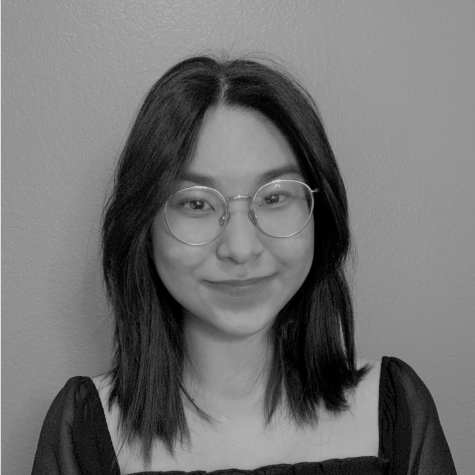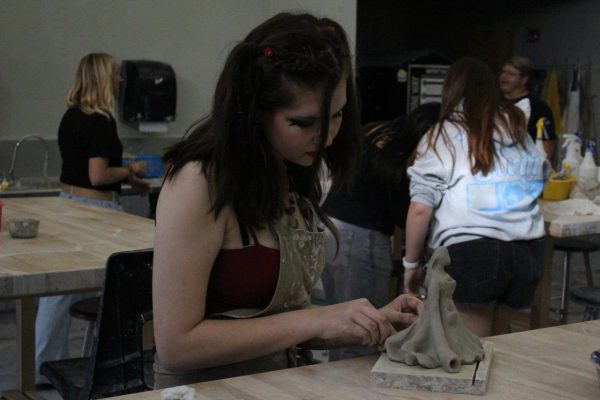Students return to campus for first time in more than a year
[metaslider id=”6795″]
Westview students began returning to campus for classes, in accordance with PUSD’s temporary one-day-a-week cohort system, on Monday.
Students wandered about, some with maps in their hands. Link Crew members guided confused freshmen to their classrooms. When the bell rang, the campus settled into its usual quiet buzz.
At first glance, this mid-semester March morning seemed like a first day of school. And in some ways, it was. A full year after the pandemic was declared—367 days since the school closed—some semblance of normalcy was finally peeking through.
It was almost enough, social science teacher DJ Sosnowski said, to forget the trials and tribulations of getting to this point.
“When you’re here in the classroom, you almost feel like you’re attending school as normal just like you did a year ago,” he said. “And then you notice the little things, like the tables and chairs piled up in the hallway to prevent students from going in.”
The off-limits hallway was only one of the differences that set the reopening apart from a regular day of school. Tables and thermometers were set up at the gates to check identification and temperatures before anyone stepped onto school grounds. Sanitizing stations and yellow “COVID safety” posters peppered the campus. Inside classrooms, desks and chairs were carefully spaced out and tall plexiglass barriers separated each seat from the others.
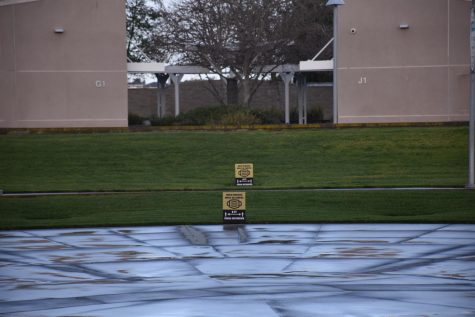
Students still had to attend Zoom meetings during class and abide by pandemic safety guidelines, which were added quirks to the normal campus life that many people sought.
Still, according to Meredith Dahl (9), just being on campus was rewarding.
“I found it so hard to focus online, so I’m grateful for the chance to see my friends and have somewhat of an education again,” Dahl said. “I was concerned at first that people weren’t going to follow social distancing rules, but so far everyone has been doing their part.”
The first two days of reopening week were designated for the freshman and sophomore cohorts. Many freshmen in particular faced classic first-day-of-school problems like getting lost. For Max DiPierro (9), whose “return” on March 16 was his first time ever on campus, reopening was overwhelming.
“It’s so chaotic, and I’m all over the place because I don’t even know where to go,” DiPierro said. “It might be too early to tell, but for now I would prefer going back to online school because of its convenience. Westview is just so big.”
Despite Dahl’s own satisfaction with in-person class so far, she said the unfamiliarity of being on campus has been equally jarring.
“It’s so weird that my ‘first day’ as a freshman in high school is in the middle of March,” Dahl said. “That was supposed to happen a long time ago. And now we’re almost done with a whole school year and I don’t know the campus yet.”
According to Campus Supervisor Mary Carpenter, the second two days of on-campus learning, with cohorts of juniors and seniors, saw a much lower turnout than the first two days. However, this low number of students, Carpenter said, didn’t make the day feel any less meaningful.
“From who I’ve talked to, the few students who are on campus really want to be here,” she said. “Some are just trying to see what [learning on campus] is like and see if they want to be here, which is great.”
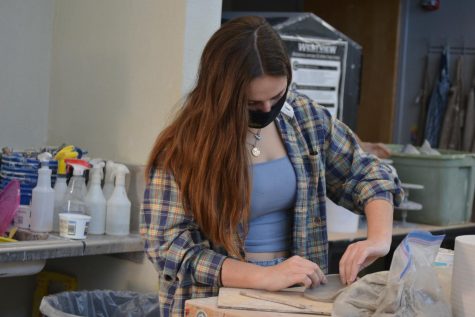
For Tyler Shaw (11), choosing to come on campus seemed like the right choice to improve his mental health.
“Being at home was hard, especially with not being able to see a lot of friends,” Shaw said. “I was dealing with some depression too. Even though I don’t have many friends at school, I think being able to see the few who are here will make it better.”
Additionally, Shaw said he chose to come to campus to increase his motivation for schoolwork.
“It’s easier for me, at school, to be motivated to do the work I have to do,” Shaw said. “When I’m at home, I’m not motivated to do the work and I’ll just watch TV instead of paying attention in class. [At school] I can’t do that.”
Choosing the on-campus learning option to increase motivation was common among juniors and seniors. Charlotte Bundley (11) said she chose to go on campus so she would be forced to “get out of her PJs” during a school day. Halle Wahlgren (12) described feeling “disengaged” in online school, which she wanted to change by returning to campus.
“I would get bored and distracted sitting at home, in my bed, on Zoom,” Walhgren said. “[On campus] I have to be attentive and I want to pay attention in my classes.”
Even the small things about the school day, according to Madeline Thomas (12), have helped her feel more motivated.
“Just getting up early enough to get here in time has made me feel more alive in class,” Thomas said.
With AP exams coming up, Sneha Jaiswal (11) said she chose to come to campus to be able to prepare without the distractions of her home.
“My whole family is always on Zoom calls,” she said. “I needed to get away from that.”
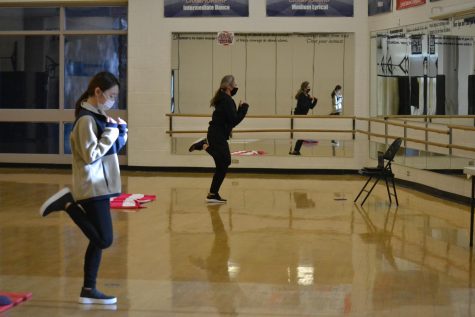
Though being on campus did increase her motivation, Wahlgren said the few in-person students in each class made the day feel “nothing like a normal school day” as she didn’t have many peers to interact with. On Wednesday, the first day of the upperclassmen cohort, teachers across campus saw small class turnouts—Ceramics teacher Hayley Filasky led two in-person students in creating bowls, Aerobics teacher Marina Henry led one in-person student in a HIIT workout, and AP Music Theory teacher Martin Fierro led only virtual students in sight singing, as no in-person students showed up for his class that day.
As an on-campus teacher, Sosnowski’s goal has been to make sure students are comfortable with both the online and in-person options. Because of the understandable concerns that being on campus presents, he said he aims to make his class experience equal for both groups.
“If you’re comfortable being on campus, then cool, we’re gonna work together,” Sosnowski said. “But if you’re not comfortable being on campus, then you shouldn’t be penalized for that.”
Teaching both in-person and over Zoom, especially with such a small in-person group, according to Filasky, feels like a “balancing act.”
“I can’t teach how I normally would in-person and I can’t teach how I’ve been teaching on Zoom,” she said. “I have to find a way to mold the two together.”
Science teacher Shannon Skelton said it’s been a trial-and-error process for her to try to blend her two teaching styles.
“I love writing on the whiteboard,” Skelton said. “It’s a great way to write out chemistry equations, draw atoms, and take notes with the kids. I tried pointing my computer camera at the whiteboard for virtual students, but it was harder for some of them to see. That’s why I think honest, constructive feedback is so important from students moving forward.”
Still, Skelton sees the small in-person class sizes as an opportunity for connections many have been missing in the past year.
“This is a really unique opportunity for students to spend time with a teacher, to get to know them in a class with maybe just two other students,” Skelton said. “I encourage my students in the classroom to take advantage of being in a classroom: to talk with each other, to laugh with each other. It may seem uncomfortable at first, but we can all work out the kinks together.”
Sosnowski said he shares this appreciation for human connection, and often recalls the “spontaneous conversations” that he would hear in his classroom pre-pandemic.
“I love listening to students, even if they’re not talking about the [academic] content,” Sosnowski said. “They’re talking about their job, or their family, or their sports team, or their extracurricular activity, and just engaging with each other person-to-person. Online learning doesn’t lend itself to that—students are well aware that everyone’s listening when they talk [on Zoom].”
For performing arts classes like Band, the lack of human connection in online school has all but thwarted students’ learning experience. GOLD Director Mitchell Way said that rehearsing in-person is a critical part of performing arts.
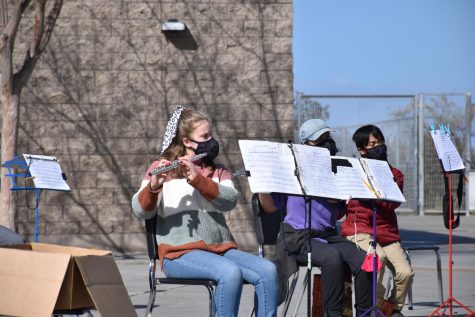
“All our ensembles in GOLD are exactly that—ensembles,” Way said. “You cannot even remotely simulate that over Zoom. Band, Orchestra, and Guard kids choose this activity for the community aspect of creating art together.”
Performing arts practices were held outdoors, in the back of Westview’s campus, to adhere to COVID guidelines. Way said this presented logistical challenges because of the rain and wind. Students also had to adjust to specialized PPE such as slit masks and instrument covers. Still, according to flute player Sarah Shaw (10), in-person Band was a welcome and much-needed change.
“Band is like a family to me,” she said. “Because I wasn’t able to see and make music with them, online class was lacking. It’s so great to come back and really experience [Band] again.”
Fine arts classes like Ceramics provide a similar advantage of studio space and materials for in-person learners. Thomas, a Ceramics student, said the open studio space is a much better working environment than her garage. Yet, being on campus also means that she has to transport her in-progress ceramic projects to and from school, which according to Filasky puts them at a big risk of breaking.
For teachers and students of all classes, reopening has been a once-in-a-lifetime experience. Even if the process is difficult, English teacher Nichole Salvo said, the cohort system has brought a unique chance for students to pick what kind of environment works for them.
“It really matters what a person’s learning style is like,” Salvo said. “There’s a great amount of flexibility at home, and this opportunity for students to do [independent work] didn’t exist before. But flexibility can also be a hindrance to students who don’t like distractions. There’s benefits to both [online and in-person], so I like that we can give students options.”
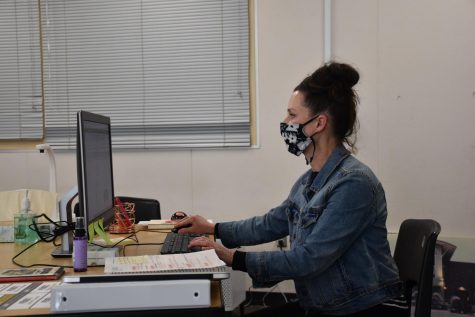
Sosnowski said that for him, reopening would be worth it as long as he could make a positive impact on the students who returned.
“The reason I decided to come back [to campus] was that I want to help students who have realized they’re struggling at home,” Sosnowski said. “Whether it’s academically, socially, emotionally, whatever the case may be—if they have determined that they would be better suited to learn on campus, I want to be here for them.”
Though slowly, the energy of Westview’s campus began returning in the first week that students did—the sound of band still echoed through campus during first period, even from a Zoom call; students still asked questions to their teachers, even if they had to shout across plexiglass dividers; and friends saw each other for the first time in months, even if they couldn’t hug in greeting.
Next week, as San Diego has moved into the red tier, PUSD will begin following an A/B model where students come to school for two days a week. With students expected to come in bigger groups, teachers and staff say they are excited to see more of this energy return.
“We should welcome all the hiccups and all the crazy things that happen [during reopening],” Salvo said. “Laugh instead of cry when something goes wrong.”
